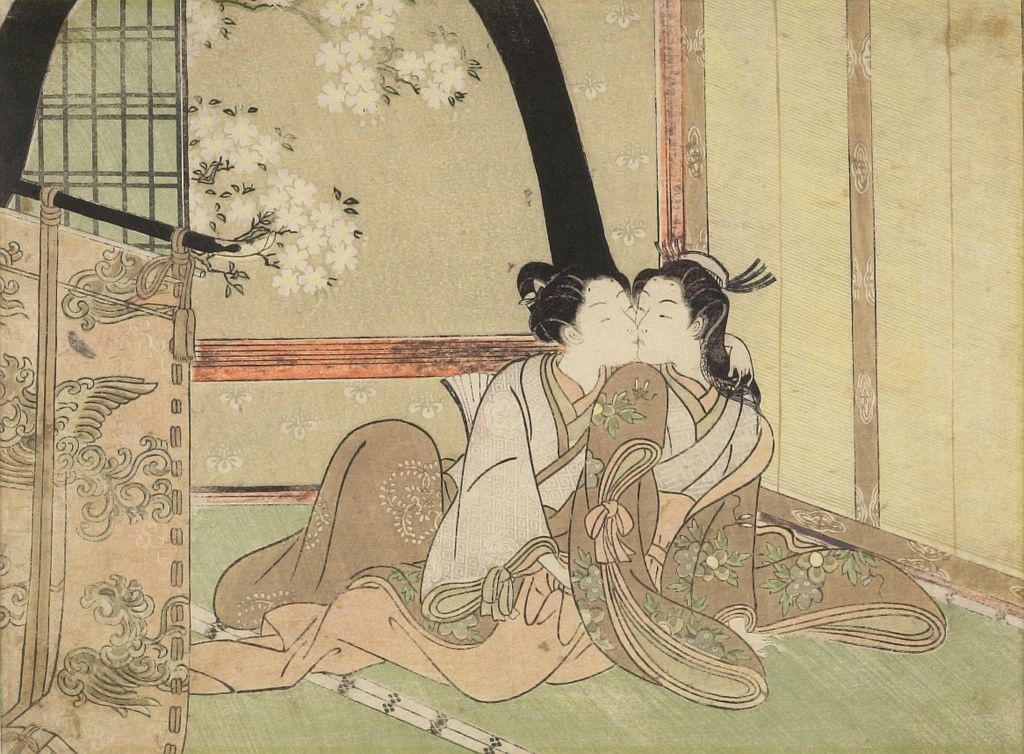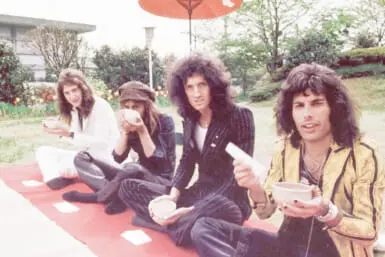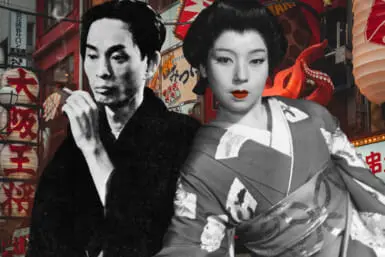Many of us are drawn to Japan from a need to find somewhere to belong. I arrived in Kanto in 2018, after three years in the deep countryside of northern Kyushu. What I found was a vibrant, hidden hotbed of LGBT and queer culture locked away from mainstream sight. In districts like Shinjuku Nichōme, Tokyo’s gay neighborhood, Japanese and foreign talk, drink, and mingle, in long-standing private bars, in clubs, in drag shows, and on the streets outside convenience stores. Here you find artists, dancers, drag entertainers, and Doutor philosophers.
This series will explore the varied queer and allied scene across Japan: the trailblazers of Japan’s LGBTQ rights movement, the flamboyant performers and cutting-edge artists, and the foreign-born residents who have carved out a place for themselves in this thriving international scene.
First, however, it would be a disservice to the Japanese LGBTQ community not to go on a whirlwind tour of Japanese history through a queer lens. While far from a Mecca of acceptance, Japan nevertheless has a number of names that resonate with queer culture today.
A rare nanshoku (male-male) handscroll is featured in Fine Japanese Works of Art https://t.co/9HaBZtrEyH #AsiaWeekNY pic.twitter.com/FGKVSVZHVV
— Bonhams (@bonhams1793) March 4, 2016
Ancient Japan to World War II
The Nanshoku Practice
Like many cultures, Japan has a long history of socially accepted relationships dating back to ancient times which, through a modern lens, have taken a queer reading. Immediately springing to mind is the practice of nanshoku, which translates to “male colors” or “male sexual pleasure.” This was a system of age-structured pederasty not unlike that of ancient Greece, involving older men with younger male companions or apprentices in their early teens. Their relationships most likely varied greatly by situation and across time periods, but a typical nanshoku pairing incorporated many dimensions: mentorship and stewardship, platonic friendship, as well as physical acts of homosexual sex.
Nanshoku dates back to the Japanese Sengoku Period (The Warring States) and earlier, and could be widely seen among samurai, monastic orders, and kabuki actors engaged in male prostitution. The practice only began to fade with the Meiji Restoration in the late 1800s, when scrutiny from the West led to a redefining of homosexuality and heterosexuality in Japanese society. Famous historical figures known to have practiced nanshoku include Oda Nobunaga (1534-1582) and his vassal Mori Ranmaru (1565-1582), who perished with him in battle.
While historical depictions of Nobunaga and Ranmaru sometimes fully portray them as gay lovers, we must be careful to separate historic nanshoku and the figures therein from LGBTQ issues today, and to avoid modernizing norms of that era to fit our concept of sexuality and romance.
We can infer queer people have always existed, and that some practitioners of nanshoku—perhaps including Nobunaga and Ranmaru—might have self-identified as queer or gay if displaced into our modern time with our modern definitions, although we cannot know for sure. Unfortunately, there were painfully few open and proud LGBTQ figures until the postwar Showa Era.
“Will the day come when we will live together under the same roof? How easy things would be if only we were a man and a woman! But alas, you are a woman…and so am I.”
*
Japanese novelist #NobukoYoshiya , Born 12 January 1896
*
*
One of her country’s mo… https://t.co/K1dUqhNxBN pic.twitter.com/RqP27OY1vz— therelevantqueer (@relevantqueer) January 12, 2020
Nobuko Yoshiya
One openly queer figure of the pre-war era whom we can rally around, however, is novelist Nobuko Yoshiya (1896-1973). A writer of the Taisho and Showa periods, Yoshiya wrote considerably in the romance genre, helping to establish both adolescent girls’ fiction and Japanese lesbian literature. In her personal life, Yoshiya was known for adopting androgynous fashion styles and lived an independent life in Tokyo when it was rare for Japanese women to remain single, or to own cars.
While not “out” in our sense of the word, Yoshiya openly lived and was in a committed relationship with her partner, Chiyo Monma, for over fifty years. Notably, Yoshiya had to formally adopt Monma as her “daughter” in order for the two to be legally bound and able to make medical decisions for one another. Even today, without legalized same-sex marriage, queer partners “adopting” one another continues to be one of the few legal loopholes for same-sex relationships in Japan. Yoshiya’s family denies her LGBTQ identity to this day.
Postwar Showa Era
Moving into modern Japan, the postwar Showa Era saw immense creative activity from figures widely regarded as queer icons today.
Keisuke Kinoshita
First among these is filmmaker Keisuke Kinoshita (1912-1998), widely considered the first queer filmmaker of Japan. A contemporary of directors like Akira Kurosawa and Yasujiro Ozu, Kinoshita was known for creating both lively comedies, like The Blossoming Port (1943), and poignant dramas with anti-war messages, such as Twenty-Four Eyes (1954). Friends, collaborators, and the rest of the film world, widely recognized Kinoshita as a queer man, though Kinoshita himself kept his personal life private. His 1959 film Sekishuncho, or Farewell to Spring, depicts intimate and emotional relationships between its male characters, and is often recognized as “Japan’s first gay film.”
Yukio Mishima is the queer, sword-fighting, weight-lifting, death cult-leading novelist you need to know.
Read @PrestonFassel‘s feature on Mishima’s life over on our Patreon: https://t.co/p3C27ogzsa pic.twitter.com/vuhfNld784
— Daily Grindhouse (@DailyGrindhouse) April 4, 2021
Yukio Mishima
Another widely known and controversial figure is author Kimitake Hiraoka, pen name Yukio Mishima (1925-1970). Something of a tortured genius deeply impacted by the war, Mishima grappled with feelings of inferiority throughout his life, seeking shelter within nationalist and pro-emperor political movements. His vast body of literature revolves around romanticizing Japanese culture and traditions and often depicts hyper-masculine and physically beautiful male characters as examples of the ideal Japanese man.
Mishima is widely regarded as queer, though this remains controversial since his family denied these rumors after his death. In addition to his homoerotic writing, Mishima was reported to have visited gay bars and to have had an affair with writer Jiro Fukushima. Many scholars of Mishima find a queer reading informs our understanding of the complicated Mishima, and the legacy of his work today.
View this post on Instagram
Ken Togo
Perhaps the polar opposite of Mishima in every sense, the vivacious “legendary okama” (Japanese slang for “transvestite” or “faggot”) Takeshi Togo — aka Ken Togo (1932-2012) —revolutionized the way postwar Japan saw queer people forever.
Originally closeted, married, and working at a bank, Togo exploded into the LGBTQ rights scene in 1963 and was (unsuccessfully) running political campaigns by the 1970s. On the side, he moonlighted as a bar owner, gay magazine editor, singer, actor, and pornographer.
Togo was a radical leftist, whose ideologies would be at home with today’s most progressive queer youth, but which put him at odds with the respectability politics of the wider LGBTQ community. A self-proclaimed okama, Togo was an ardent activist for sexual minority issues, ranging from LGBTQ to sex worker rights. His open mockery of the emperor often brought the ire of right-wing parties. His political affiliation, he said, was to the Zatsumin no Kai (Association for Miscellaneous People) and there was seemingly no issue or societal reject he would not rally for.
Living Legends
Other prominent queer icons and activists who became active in the postwar Showa Era and who are fortunately still alive today include drag queen Akihiro Miwa, Kenichi Mikawa, and Maki Carrousel.
Akihiro Miwa is primarily known for his career in singing, his film roles, and his alleged relationship with Yukio Mishima. He’s also openly gay, a drag queen, and a survivor of one of the atomic bombs. You might recognise his voice in Howl’s Moving Castle and Princess Mononoke. pic.twitter.com/IrkB7IwfMD
— Calvin (@CaliShirogane) April 12, 2018
Akihiro Miwa
A close friend of the late Yukio Mishima, Akihiro Maruyama — stage name Akihiro Miwa (born 1935) — is a celebrated singer, actor, writer, and drag queen, with a career spanning nearly seventy years and over twenty books. A survivor of the Nagasaki atomic bomb, Miwa moved to Tokyo in his teens to perform in Ginza’s cabaret scene and quickly gained popularity for his singing and effeminate looks. Ghibli fans would know him from voice acting in Ghibli films.
Like Togo, Miwa publically came out as LGBTQ at a time when very few were at liberty to do so, let alone entertainers so prominent in the public eye. In addition to his writing and career in music, Miwa is known for his criticism of the government and strong anti-war stance.
Kenichi Mikawa
When many people think of queer Japanese icons, enka singer Kenichi Mikawa (born 1946) is one name that springs to mind. Born Yoshikazu Momose, Mikawa launched his singing career in the mid-1960s. Beginning in the 1980s, he began adopting a flamboyant one (“older sister”) style, for which he attained new heights of fame. When performing and appearing on television, Mikawa often dresses in an androgynous, glamorous diva attire and remains in his one character.
View this post on Instagram
Maki Carrousel
Maki Hirahara, also known as Maki Carrousel (born 1942), is a writer, singer, and actor, who was one of the first openly transgender women in Japan and known recipients of gender affirmation surgery, when she sought an unlicensed surgeon in Sapporo at the age of nineteen. Carrousel’s journey through operations, complications, and subsequent corrections spanned over a decade, all while managing her rising career in cabaret singing. Within the Nichigeki Revue, Carrousel was one of the most admired performers.
She has continued pushing the envelope with transgender rights, after an incident in 2001 when police arrested and detained her within a men’s jail for forty-one days. This prompted a long legal struggle which ended in 2004 when the Tokyo Family Court allowed Carrousel to become one of the first transgender applicants to legally change their sex within the family registers. Unfortunately, legal transition continues to be nigh unreachable for most transgender people who do not pass the court’s rigorous code.
At the age of seventy-eight, Carrousel continues to perform on stage and has enjoyed being cast in femme fatale roles on mainstream television.
Moving Forward
The above is far from a comprehensive list of all the queer, gay, and transgender people who have played a part in shaping Japan’s LGBTQ legacy. Politicians and queer writers and filmmakers make up only a fraction of what it meant to be queer in eras past, and what it means to be queer in Japan today.
As the week of Tokyo Pride approaches at the end of April, I encourage you to look at your friends and neighbors in the LGBTQ fabrics — from private folks still in the closet to outspoken drag queens and bar proprietors — and to recognize that we are each a small part of the world’s queer culture, and each building a small piece of its history.
Read the next Queer Japan column – TW Queer Japan: LGBTQ Icons in Japan Today
Written with input and assistance from Yutaka Kubo, associate professor in film studies at Kanazawa University.
TW Queer Japan is a regular column that throws a spotlight on important topics and people from the LGBTQ community in Japan. If you have any stories to share feel free to contact us at editor@weekender.com
Read similar stories:
- The Monk In Mascara: The Gender Fluid Monk Who Divides His Time Between Makeup Artistry and a Tokyo Monastery
- Bringing More LGBT Diversity in Teaching with English Unlimited
- What’s It Like Being Mr Gay Japan?
- 5 Less-Known LGBT Movies To Watch on Netflix Japan This Year
Top image: Ukiyo-e print, “Women Embracing in a Green House”, Edo period, circa 1765-1770 – by Suzuki Harunobu









